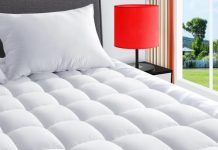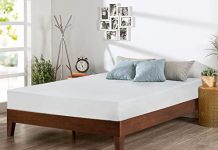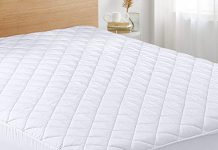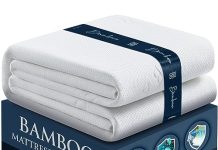Imagine sleeping on the same mattress for 20 years – it’s almost unimaginable!
But as your trusted friend, I’m here to answer an important question: Is a 20-year-old mattress too old?
We all know that a good night’s sleep is vital for our well-being, so let’s explore the factors that come into play when determining the longevity of a mattress.
Review contents
Signs of a Worn-Out Mattress
Sagging or Indentations
One of the first signs that your mattress is worn out is sagging or indentations. Over time, the materials in the mattress can break down and lose their shape, causing the mattress to develop areas that sink lower than others.
This can lead to discomfort and can affect your quality of sleep. If your mattress is no longer providing support and has noticeable sagging or indentations, it may be time to consider replacing it.
Visible Wear and Tear
Another sign of a worn-out mattress is visible wear and tear. This can include fraying or unraveling edges, stains, or rips in the fabric.
If your mattress looks worn and damaged, it’s a good indicator that it has reached the end of its lifespan. Not only can these signs be unappealing, but they may also impact your comfort and the overall durability of the mattress.
Loss of Support
As a mattress age, it can lose its ability to support your body adequately. This can result in poor alignment of your spine and joints, leading to discomfort and potential pain.
Notice that your mattress no longer provides the same level of support as it used to, especially in the areas where you need it most, such as your lower back or hips. It may be time to consider investing in a new mattress supporting your body.
Uncomfortable Sleep
If you toss and turn throughout the night or wake up feeling more tired than when you went to bed, your mattress could be the culprit.
An uncomfortable sleep surface can indicate that your mattress is worn out and can no longer provide the comfort you need. This can lead to restless nights, decreased sleep quality, and ultimately, a negative impact on your overall well-being.
Allergies or Breathing Issues
A worn-out mattress can also contribute to allergies or breathing issues. Over time, mattresses can accumulate dust mites, allergens, and other particles that can trigger allergies and respiratory problems.
If you find yourself experiencing worsened allergies or breathing difficulties while sleeping, it may be worth considering whether your mattress is causing or exacerbating these issues.
Health Risks
Dust Mites and Allergens
One of the health risks associated with an old mattress is the presence of dust mites and allergens. Dust mites are microscopic creatures that feed on dead skin cells and are commonly found in mattresses.
As a mattress age, it becomes a breeding ground for dust mites and can harbor high allergens. This can trigger allergies and respiratory problems, causing discomfort and affecting sleep quality.
Mold and Mildew Growth
Another health risk associated with a worn-out mattress is the potential growth of mold and mildew. Moisture from sweat and other bodily fluids can seep into the mattress over time, creating an environment conducive to the growth of mold and mildew.
These fungi can release spores into the air, leading to respiratory issues and other health concerns. If you notice a musty smell or visible signs of mold or mildew on your mattress, it’s essential to replace it to prevent any further health risks.
Bed Bugs Infestation
Bed bugs are another unwelcome guest that can make their home on an old mattress. These small, blood-sucking insects can multiply quickly and cause itchy, red bites on your skin.
If you notice signs of bed bugs, such as small dark spots or blood stains on your sheets, it’s essential to act promptly and replace your mattress to prevent the infestation from spreading to other areas of your home.
Back and Neck Pain
Sleeping on a worn-out mattress can lead to back and neck pain. A mattress that no longer provides adequate support can cause spine misalignment and added pressure on specific body areas.
This can result in discomfort, stiffness, and pain upon waking up. If you consistently experience back or neck pain, it may be worth considering whether your mattress contributes to these issues.
Sleep Disruptions
An old mattress can significantly disrupt the quality of your sleep. As the mattress wears out, it can become lumpy, uneven, and uncomfortable, making it difficult to find a comfortable sleep position.
This can lead to restless nights, frequent waking up and difficulty falling asleep. If you find yourself experiencing sleep disruptions regularly, it may be time to evaluate the condition of your mattress and consider investing in a new one.
Factors That Impact Mattress Lifespan
Quality of Materials
The quality of materials used in a mattress can significantly impact its lifespan. Mattresses made with high-quality materials, such as durable foams or coils, tend to be more resilient and last longer.
On the other hand, mattresses made with lower-quality materials may wear out more quickly and require replacement sooner. When purchasing a new mattress, it’s essential to consider the quality of the materials used to ensure you’re investing in a durable and long-lasting product.
Frequency of Use
The frequency of use also plays a role in determining the lifespan of a mattress. A mattress used every night will generally wear out more quickly than one used occasionally, such as in a guest bedroom.
If you have a heavily utilized mattress, it may require replacement sooner than a less frequently used one.
Body Weight
Another factor that can impact the lifespan of a mattress is the body weight of the sleeper(s). Heavier individuals tend to exert more pressure on the mattress, which can cause it to wear down faster. If you have a higher body weight, choosing a mattress specifically designed to provide adequate support and durability for your body type is essential.
Maintenance and Cleaning
Proper maintenance and cleaning can help extend the lifespan of a mattress. Regularly vacuuming the mattress, using a mattress protector, and following the manufacturer’s cleaning recommendations can help prevent the buildup of allergens, dust mites, and other particles that can contribute to the deterioration of the mattress. By maintaining a clean and hygienic sleep surface, you can help prolong the lifespan of your mattress.
Recommended Lifespan for Mattresses
Different Types of Mattresses
The lifespan of a mattress can vary depending on your mattress type. Different mattresses, such as memory foam, innerspring, latex, and hybrid mattresses, have varying durability and longevity.
Memory foam mattresses, for example, tend to have a longer lifespan of around 8-10 years, while innerspring mattresses may last around 5-7 years. Latex and hybrid mattresses often fall somewhere in between, with an average lifespan of 7-9 years.
Average Lifespan of Mattresses
On average, most mattresses tend to last between 7-10 years. However, this is a general guideline, and individual factors, such as quality of materials and maintenance, can influence how long a mattress will last.
Some mattresses may show signs of wear and tear before the 7-year mark, while others may remain in good condition for longer. It’s essential to assess the condition of your mattress regularly and consider replacing it if it exhibits significant signs of aging.
When to Replace a Mattress
While the average lifespan of a mattress can provide a rough estimate, it’s essential to evaluate the condition and comfort of your mattress rather than solely relying on its age. If your mattress shows noticeable signs of wear, such as sagging, indentations, or loss of support, it may be time to replace it.
Additionally, if you consistently experience discomfort, pain, or sleep disruptions that can be directly attributed to your mattress, it’s worth considering investing in a new one. Ultimately, the decision to replace a mattress should be based on its condition and the level of comfort it provides.
Extending the Lifespan of a Mattress
Using a Mattress Protector
One of the simplest ways to extend the lifespan of your mattress is by using a mattress protector.
A mattress protector acts as a barrier between your body and the mattress, helping to prevent stains, spills, and the accumulation of dirt, dust mites, and other allergens. Keeping your mattress clean and protected can help maintain its condition and prolong its lifespan.
Regularly Cleaning and Vacuuming
Regular cleaning and vacuuming of your mattress can help remove dust, allergens, and other particles contributing to its degradation. Use a handheld vacuum or a vacuum cleaner with an upholstery attachment to remove loose debris.
Additionally, spot clean any stains or spills promptly using a gentle cleaning solution recommended by the manufacturer. Keeping your mattress clean and free from buildup can help preserve its integrity and extend its lifespan.
Flipping and Rotating the Mattress
Some mattresses, particularly those with double-sided designs, can benefit from flipping and rotating. This can help distribute the wear and tear evenly across the mattress, preventing excessive sagging or indentations in one area.
Check the manufacturer’s guidelines to determine whether your mattress is suitable for flipping or rotating, and if so, follow the recommended schedule to ensure proper maintenance.
Avoiding Jumping or Rough Handling
Avoiding jumping or engaging in rough handling is essential to prevent unnecessary stress and strain on your mattress. Excessive jumping or rough treatment can cause the materials inside the mattress to break down more quickly, leading to premature wear and tear. Treating your mattress carefully and using it solely for its intended purpose can help prolong its lifespan.
Investing in a Mattress Topper
If your mattress is starting to show signs of wear but is not ready to invest in a new one, a mattress topper can be a cost-effective solution.
A mattress topper is a removable layer of cushioning that sits on top of the mattress, providing additional comfort and support. Adding a mattress topper can help alleviate some of the discomfort caused by a worn mattress and extend its usability until you’re ready for a replacement.
When to Consider Replacing a 20-Year-Old Mattress
Visible Deterioration
A 20-year-old mattress is likely to exhibit visible signs of deterioration. The materials inside the mattress may have worn down significantly, leading to sagging, indentations, and unevenness. If your mattress has become lumpy, uncomfortable, or visibly deteriorated, it indicates it’s time for a replacement.
Lack of Support and Comfort
As a mattress age, it loses its ability to provide adequate support and comfort. If your 20-year-old mattress is no longer supportive and causes discomfort while sleeping, it’s a sign that it has reached the end of its lifespan. A lack of support can lead to alignment issues, pressure points, and increased sleep disturbances.
Persistent Allergies or Breathing Issues
An old mattress can harbor allergens, dust mites, and other particles that trigger allergies or breathing issues. If you continue to experience persistent allergies or breathing difficulties while sleeping, even after proper cleaning and maintenance, it could indicate that your old mattress contributes to these problems.
Worsening Sleep Quality
One of the primary purposes of a mattress is to provide a comfortable and restful sleep. If your 20-year-old mattress is causing increased sleep disruptions, tossing and turning, or restless nights, it’s a clear sign that it’s no longer suitable for providing the quality sleep you need. Investing in a new mattress can significantly improve sleep quality and overall well-being.
Waking Up with Aches and Pains
Waking up with aches and pains, especially in the back and neck, can result from sleeping on an old, worn-out mattress. As the mattress loses its ability to support your body correctly, it can lead to misalignment and added pressure on sensitive areas.
If you consistently wake up with discomfort or pain, it’s time to say goodbye to your 20-year-old mattress and invest in a new one that can provide the necessary support and comfort.
Benefits of Buying a New Mattress
Improved Sleep Quality
Investing in a new mattress can significantly improve your sleep quality. A mattress that is supportive, comfortable, and suited to your individual preferences can help you achieve better sleep, leading to increased energy levels, improved mood, and overall enhanced well-being. A new mattress can help you wake up feeling refreshed and rejuvenated by providing the right balance of support and comfort.
Better Support and Alignment
A new mattress can provide superior support and alignment for your body. With improved materials and innovative designs, modern mattresses are engineered to promote proper spinal alignment and alleviate pressure points.
By choosing a mattress customized to your sleep needs, you can ensure that your body is adequately supported throughout the night, reducing discomfort and improving sleep quality.
Reduced Allergens and Dust Mites
A new mattress can also help reduce allergens and dust mites, promoting a healthier sleep environment.
Many modern mattresses are designed with hypoallergenic materials and features that resist the accumulation of allergens and dust mites. Investing in a new mattress can create a cleaner and more hygienic sleep surface, reducing the risk of allergies and respiratory issues.
Enhanced Overall Comfort
The primary purpose of a mattress is to provide comfort, and a new mattress can deliver just that. With advancements in technology and materials, mattresses today offer enhanced cushioning, pressure relief, and temperature regulation, ensuring a comfortable and enjoyable sleep experience. By upgrading to a new mattress, you can enjoy the benefits of improved comfort and create a more inviting sleep environment.
Decreased Pain and Discomfort
If you suffer from chronic pain conditions, a new mattress can significantly affect your overall comfort.
Mattresses designed with pressure-relieving materials, such as memory foam or latex, can help alleviate pain and reduce discomfort, allowing you to sleep more peacefully. By choosing a mattress that addresses your specific pain needs, you can experience a noticeable decrease in pain and wake up refreshed.
Common Mistakes When Purchasing a New Mattress
Not Considering Personal Sleep Preferences
One common mistake when purchasing a new mattress is not considering your personal sleep preferences. Everyone has different comfort preferences, such as firmness level, mattress type, and sleeping position compatibility. It’s essential to consider your preferences and needs to ensure that you choose a mattress that suits your unique sleep style.
Ignoring Individual Body Needs
When buying a new mattress, ignoring your body’s needs can also be a mistake. Factors such as body weight, health conditions, and specific support requirements should be considered. For example, a heavier individual may require a firmer mattress to provide adequate support. At the same time, someone with chronic back pain may benefit from a mattress that offers targeted pressure relief in specific areas.
Choosing the Wrong Size
Choosing the wrong mattress size can lead to discomfort and sleep disruptions. It’s essential to consider your sleeping habits, body size, and any potential changes in sleeping arrangements when selecting a mattress size.
For couples, a larger size, such as a queen or king, may be more suitable to ensure ample space for comfortable sleep.
Neglecting to Test Mattress Options
Not testing various mattress options can be a mistake when purchasing a new mattress.
Each individual has different comfort preferences, and what may suit one person may not be suitable for another. It’s crucial to physically try out different mattresses and spend enough time lying down in different positions to ensure the right level of comfort and support.
Failing to Research and Compare
Failing to research and compare mattress options can result in an uninformed purchase. Researching different mattress brands, types, and customer reviews is essential to understand the options comprehensively.
Comparing prices, warranties, and return policies can help you make an informed decision and get the best value for your money.
Factors to Consider When Buying a New Mattress
Mattress Size and Dimensions
When buying a new mattress, one of the first factors to consider is the size and dimensions. The mattress size should be determined by the number of sleepers and the available space in your bedroom. Standard sizes include twin, full, queen, king, and California king, each offering different dimensions to suit various needs.
Mattress Type and Materials
Another essential factor to consider is the mattress type and materials. Different mattress types, such as memory foam, innerspring, latex, or hybrid mattresses, offer different levels of support and comfort.
Additionally, the materials used to construct the mattress can impact its durability, breathability, and overall feel.
Firmness Level and Support
A mattress’s firmness level and support are subjective and should be determined by individual preferences and body needs.
Choosing a mattress that provides the right balance of support and comfort for your body type and preferred sleep position is essential. Options range from plush and medium-firm to extra firm, allowing you to select the firmness level that best suits your sleep needs.
Sleeping Position Compatibility
Different sleep positions require different levels of support and pressure relief. For example, side sleepers generally benefit from a mattress that offers cushioning and contouring to alleviate pressure on the hips and shoulders.
Back sleepers may prefer a mattress with medium-firm support to maintain proper spinal alignment. Consider your preferred sleep position and select a mattress that is compatible with it.
Budget and Value for Money
Setting a budget and considering the value for money is essential when purchasing a new mattress.
Mattress prices vary significantly depending on the brand, materials, and additional features. Setting a realistic budget and focusing on mattresses that offer the best combination of quality, durability, and comfort within your price range is essential.
Conclusion
Assessing the condition of your mattress and understanding the need for replacement is critical to ensuring a restful and comfortable sleep environment.
A 20-year-old mattress is likely past its prime and may exhibit signs of wear and tear that can negatively impact your sleep quality, comfort, and health. By being aware of the signs of a worn-out mattress and the potential health risks associated with an old mattress, you can make an informed decision on when to replace it.
Investing in a new mattress offers several benefits, including improved sleep quality, better support and alignment, reduced allergens and dust mites, enhanced comfort, and decreased pain and discomfort.
Avoid common mistakes when purchasing a new mattress and consider factors such as mattress size, type, firmness level, sleeping position compatibility, and budget.
Remember, your mattress is crucial to your overall health and well-being. It’s worth investing in a quality mattress that prioritizes comfort, support, and sleep quality.
By choosing wisely and caring for your new mattress, you can enjoy restful nights and wake up refreshed, revitalized, and ready to take on the day.
































